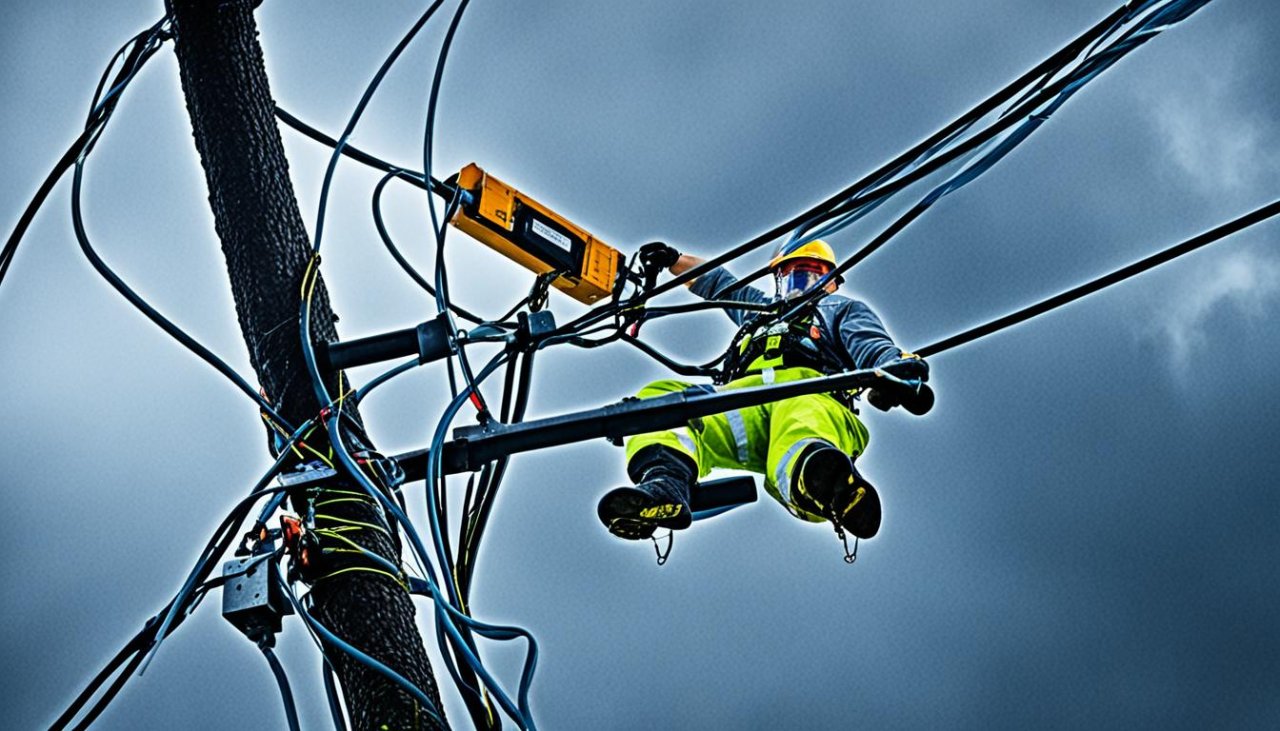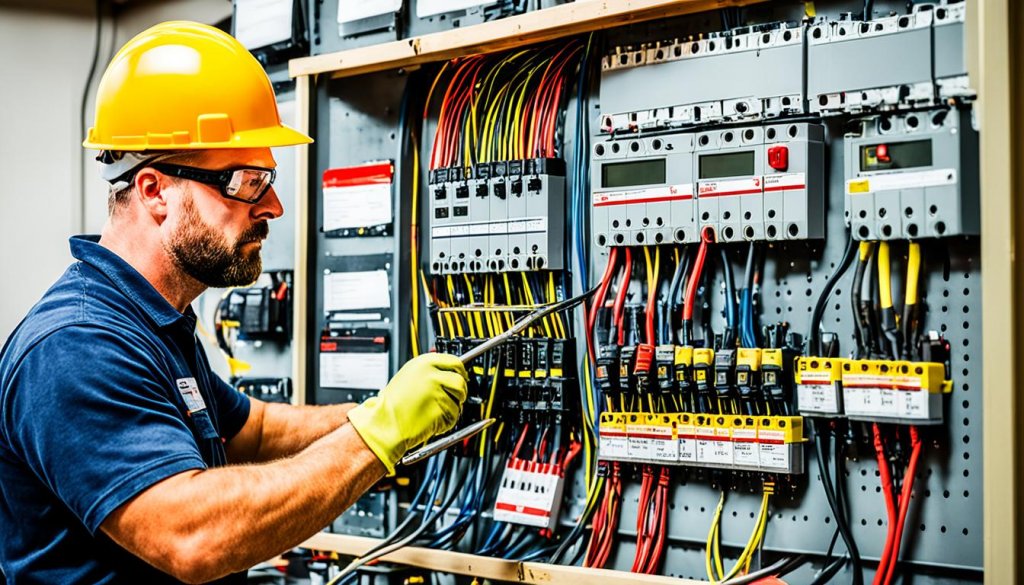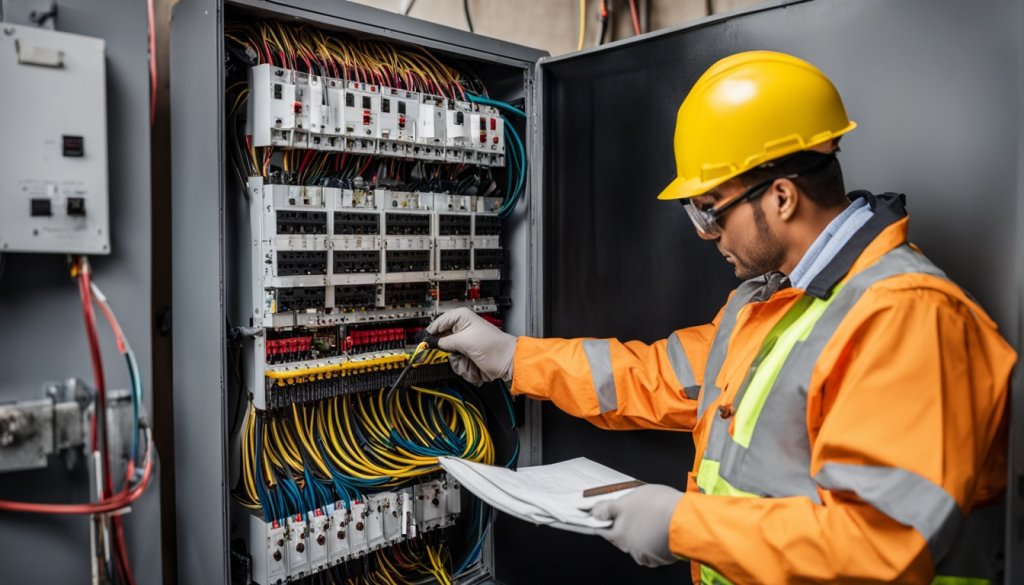Have you ever thought about the dangers that electricians face during service calls? They risk their lives every day. Ensuring their safety is crucial. This article will cover how to keep electricians safe, from knowing the dangers to following best practices.
It’s important to focus on safety for electricians. We’ll look at rules, guidelines, and ways to prevent accidents. These steps can save lives and improve work performance.

Key Takeaways
- The severity of electric shock depends on current intensity, its path, and how long it lasts.
- Even low voltages can be risky, especially if you’re exposed for a long time.
- Don’t ignore electrical hazards like frayed wires and flickering lights.
- Wearing the right protective gear is key based on the risks you face.
- Following safety rules, like using grounded equipment, is a must.
- Keeping everyone accountable helps keep safety standards high on the job.
Understanding the Importance of Electrical Safety
Electrical safety is key for technicians. I often work with electrical systems and know how vital safety is. It keeps technicians safe and reduces risks from electrical hazards at work.
Defining Electrical Safety for Technicians
Electrical safety means following certain rules and practices. If electricity is not handled right, it can cause serious harm or even death. It’s important for workers to know these safety steps well.
Using tools like the Thermo Clip™ from IRISS helps a lot. It attaches to wires of different sizes and checks equipment health. This prevents equipment from failing and reduces injuries.
Statistics on Electrical Hazards
Statistics show how big of a problem electrical hazards are. The U.S. Bureau of Labor Statistics says thousands get hurt every year from electrical accidents. This shows why training is so important.
Not having enough training can lead to deadly accidents. Employers could be held responsible. Knowing about electrical dangers like overloaded circuits and faulty wiring helps technicians prevent these issues.
Key Electrical Safety Best Practices
Keeping safe during electrical work is very important. Following electrical safety tips helps lower the risks. Using personal protective equipment (PPE) is key to staying safe. The right PPE acts as a shield against dangers.
Choosing the right PPE for each task is crucial. It depends on the risks you face.
Utilizing Personal Protective Equipment (PPE)
Personal protective equipment is your first defense when working with electricity. It includes gloves, helmets, and safety glasses. These items protect you from different electrical dangers.
I make sure my tools and gear meet the standards of a trusted testing lab like Underwriters Laboratories Inc. Regular checks keep them in good shape, so they work well when you need them.
Establishing Safe Work Environments
It’s vital to make work areas safe to lower accident risks. Keep electrical gear away from water and ensure cords are properly set up. A clean workspace also helps keep things safe.
Having clear rules, like doing visual checks and following the Three-Point Test during lockout/tagout, helps manage risks well.
Electrical Technician Safety Guidelines
As an electrical technician, it’s crucial to follow strict safety rules for my safety and the safety of others. Doing thorough safety checks before starting a job helps reduce risks. It also encourages a safe work environment.
Pre-job Safety Checks
Before starting a job, I do detailed safety checks. I check my tools and make sure all equipment works well. I keep my work area safe by removing any dangers and keeping liquids away from electrical gear.
Ground Fault Circuit Interrupters (GFCIs) are key to stop shocks and fires. If I see flickering lights, I check for loose wires right away.

Proper Handling of Tools and Equipment
Handling tools safely is key to avoiding electrical accidents. I pull electrical gear by the plug, not the cord, to prevent damage. I use non-conductive tools and wear safety gloves, and keep my hands dry.
It’s important to turn off power before fixing any equipment. I don’t work with electrical devices if I’m wet or sweating. These steps help create a safe work space and lower the risk of accidents.
OSHA Electrical Safety Regulations
The Occupational Safety and Health Administration (OSHA) has set up electrical safety rules to protect workers. These rules are key to lowering risks in electrical work. They focus on controlling hazardous energy and keeping safe distances from live circuits.
Overview of Key OSHA Standards
Learning about OSHA’s standards is a must in my job. They cover things like wiring and safe work practices for various industries. OSHA works with groups like the National Fire Prevention Association (NFPA) to create important safety guidelines.
Following these rules greatly lowers the risk of serious accidents like arc flashes and electrocution. These are big hazards in the workplace.
Ensuring Compliance in Daily Operations
It’s important to follow OSHA’s electrical safety rules every day. For instance, making sure job sites have clear circuit and equipment details helps pass OSHA checks. Not following these rules can lead to fines up to $70,000 for serious violations.
In states with stricter OSHA plans, following these rules is even more important. By learning and applying these rules, I help create a safe work environment for everyone.
Common Electrical Hazards and Prevention Tactics
It’s vital for technicians to know about electrical hazards to stay safe. The construction world sees a lot of electrical deaths. So, it’s key to quickly spot and fix these risks.
Looking for electrical dangers isn’t just about what you can see. You need to watch out for things like exposed wires, too many devices on one circuit, and working in wet areas. These can all increase the chance of accidents.
Identifying Potential Electrical Risks on Site
When I’m on the job, I always check the area for any dangers. Overhead power lines are a big risk, leading to serious injuries like burns and electrocution. Broken tools and equipment can make things even worse.
Not having the right grounding is also a big no-no, as it’s against OSHA rules and increases the risk of getting electrocuted. Knowing these risks helps us avoid them, keeping everyone safe.
Implementing Effective Hazard Prevention Strategies
To prevent hazards, I use strategies that fit the job site. Ground Fault Circuit Interrupters (GFCIs) are key in wet conditions to manage risks. Keeping cords tidy helps avoid accidents from tangled or broken cords.
Regular checks on electrical systems are a must for safety. So is training technicians on safety. I make sure all gear is UL approved and power strips have overload protection. These steps help cut down on electrical problems at work.
Electrician Safety Procedures to Follow
As an electrician, it’s crucial to follow safety steps before starting work. This ensures my safety and the safety of others. I always wear the right protective gear and check my tools before starting a job. This helps avoid risks like electrical shocks, burns, or falls.
Steps to Take Before Initiating Work
First, I do a risk assessment to spot potential dangers with the electrical gear I’ll use. I look at how likely and serious these risks are. I also check portable tools often to stop accidents from happening.
For tools at lower risk, I do regular visual checks to make sure they’re safe. These steps help make the workplace safe.
Protocol for Handling Emergencies
If an emergency happens, knowing what to do is key. I’m trained to act fast if there’s an electrical shock or equipment failure. I can quickly figure out what to do in these situations.
If someone gets an electric shock, I make sure to turn off the power first. Then, I help them. Knowing when to call for professional help is also crucial. Quick action can really make a difference in emergencies.

Electrical Safety Training for Technicians
Electrical safety training is key for keeping technicians updated on the latest safety rules and practices. From 2019 to 2021, workplace deaths from electrocution went up by 3.75 percent. This shows why ongoing learning is crucial for jobs like electricians and construction workers.
Importance of Ongoing Education
Creating a safety-first culture is vital to avoid accidents. Regular training teaches technicians about their duties and the dangers they might face. Programs should focus on important topics and be designed for the right audience.
Good training meets OSHA standards and lowers the risk of legal trouble from not following the rules.
Recommended Training Programs and Resources
Using top-notch training resources makes learning better. Courses that mix practical skills with theory are best. Many places need technicians to do both electrical certificate courses and on-the-job training.
Online classes, like those from 360training, give the basics of electrical safety. Tools like SafetyCulture’s Training feature help track how well safety training works. This tool gives companies features like pre-made courses, analytics, and reports to make their training better.
Workplace Electrical Safety Tips for Technicians
Creating a strong safety culture at work is key to keeping technicians safe from electrical dangers. It’s important that everyone works together to make safety a top priority. Each team member must see how following safety rules helps protect them.
Creating a Culture of Safety
For a real safety culture, technicians need to take responsibility for their actions. Everyone has a part in keeping the workplace safe. Doing things like turning off equipment before starting work helps lower risks. Using the right protective gear and handling tools safely also cuts down on dangers.
When the whole team supports safety, the risk of accidents goes down.
Encouraging Open Communication about Safety Hazards
Talking openly about safety is vital. Regular meetings are a good time to discuss safety risks and how to handle them. When my coworkers feel free to share their safety concerns, trust grows. It shows that everyone is on the same page about safety.
I believe in treating all electrical parts as live. This makes talking about safety easy and natural. It also gives technicians the power to act when they see risks.
Conclusion
Ensuring technician safety during electrical work is a team effort. It’s important to know the dangers and follow OSHA rules. This helps lower the risk of accidents.
Training and a focus on safety are key. By educating ourselves and talking openly about safety, we make our workplace better. We must handle equipment safely and know what to do in emergencies.
Being safe helps everyone – the workers, the companies they work for, and the people they serve. Being proactive about safety means fewer accidents, happier workers, and keeping everyone safe. Let’s keep focusing on electrical technician safety to make our work safer and more effective.
See how FieldAx can transform your Field Operations.
Try it today! Book Demo
You are one click away from your customized FieldAx Demo!
FAQ
What are electrical technician safety best practices?
Electrical technicians should use personal protective equipment (PPE) like gloves, helmets, and safety glasses. They should also keep electrical equipment away from water and install cords correctly. A clutter-free workspace is also important.
Why is electrical safety important for technicians?
Electrical safety is crucial for technicians’ well-being. It helps prevent serious injuries and deaths. Following safety rules and guidelines greatly lowers these risks.
What are some common electrical hazards technicians should be aware of?
Technicians should watch out for exposed wires, overloaded circuits, and wet conditions. Spotting these risks early helps keep the work area safe.
What does OSHA require for electrical safety?
OSHA rules say technicians must lock off machinery for maintenance and keep a safe distance from live circuits. Following these rules is key to keeping technicians and the public safe.
How can I implement effective hazard prevention strategies?
Use Ground Fault Circuit Interrupters (GFCIs) and manage cords properly. Regular safety checks can spot and fix risks early.
What electrical safety training is recommended for technicians?
Technicians need ongoing learning. This includes hands-on training and learning from real-life scenarios. Industry certifications and online courses help keep safety knowledge sharp.
How can I create a culture of safety in the workplace?
Encourage talking openly about safety risks and make sure everyone knows the dangers. Safety meetings can highlight its importance and spark ideas for improvement.
Author Bio
Co-Founder & CMO at Merfantz Technologies Pvt Ltd | Marketing Manager for FieldAx Field Service Software | Salesforce All-Star Ranger and Community Contributor | Salesforce Content Creation for Knowledge Sharing






